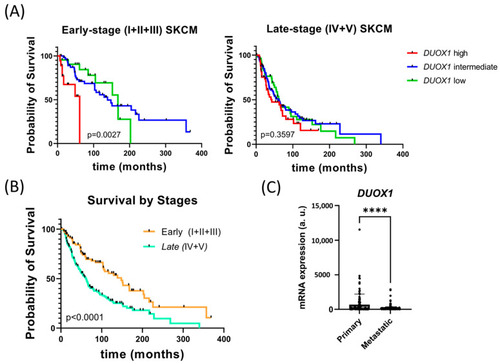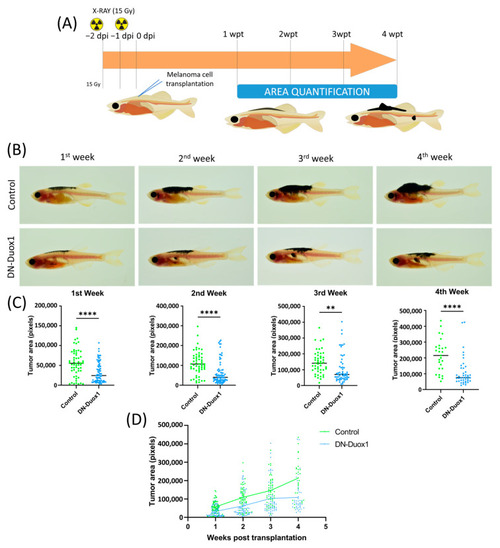- Title
-
Dual Role of DUOX1-Derived Reactive Oxygen Species in Melanoma
- Authors
- Pardo-Sánchez, I., Ibañez-Molero, S., García-Moreno, D., Mulero, V.
- Source
- Full text @ Antioxidants (Basel)
|
DUOX1 expression correlates with survival in SKCM patients and decreases in metastatic SKCM. (A) Kaplan–Meier survival analysis of TCGA cohort of early- (I + II + III Clark levels at diagnosis) and late- (IV and V Clark levels at diagnosis) stage SKCM patients according to their DUOX1 transcript levels: first quartile (Low), second and third (Medium) and fourth (High). Early-stage melanoma: Low, n = 22; Medium, n = 59; High, n = 16. Late-stage melanoma: Low, n = 57; Medium, n = 100; High, n = 60. Statistical significance was calculated with Mantel–Cox test. (B) Kaplan–Meier survival analysis of TCGA cohort of SKCM patients according to Clark-level classification at diagnosis: early-stage (I + II + III, n = 99) and late-stage (IV + V, n = 217). Statistical significance was calculated with Mantel–Cox test. (C) DUOX1 transcript levels in primary (n = 102) and metastatic (n = 360) SKCMs from TCGA cohort. Each dot represents a patient, and the mean is also shown. **** p < 0.0001 according to unpaired Student t test. a.u., arbitrary units. |
|
Melanocyte DUOX1 inhibition does not affect melanocyte transformation and early melanoma progression. (A) Schematic representation of the procedure to co-express oncogenic NRAS-Q61R and DN-DUOX1 in melanocytes. Zebrafish one-cell Casper zebrafish embryos were injected with MinicoopR mitfa:NRAS-Q61R and either MinicoopR mitfa:DN-DUOX1 or MinicoopR mitfa:EGFP (control). Larvae were examined at 5 dpf for the presence of melanocytes and images were acquired monthly for 3 months to track melanoma development. (B) Representative images of the five different categories established to classify tumor progression. (C) Percentages of fish in the different categories at 30, 60, 75 and 90 dpf. (D) Tumor free curve. Representation of the percentage of fish without nodular tumors. |
|
DUOX1 inhibition autonomously reduces aggressiveness and growth of transplanted SKCMs. (A) Schematic diagram showing adult allotransplantation procedure. One-year-old Casper zebrafish were irradiated 2 days before transplantation to prevent tumor rejection. Three hundred thousand cells from the nodular tumors of either MinicoopR mitfa:NRAS-QW61R/mitfa:DN-DUOX1 or MinicoopR mitfa:NRAS-Q61R/mitfa:EGFP (control) fish were subcutaneously injected in pre-irradiated recipients, and images were taken weekly during the following 4 weeks after transplantation and analyzed as indicated in the Methods and Materials section. Arrow, timeline; dpi, days post-injection; wpt, weeks post-transplant. (B) Representative images of transplanted melanoma growth rate of MinicoopR mitfa:NRAS-QW61R/mitfa:DN-DUOX1 and MinicoopR mitfa:NRAS-Q61R/mitfa:EGFP in pre-irradiated adult Casper zebrafish. (C) Average tumor size for each week post-transplant. Each dot represents a recipient-transplanted fish, and the mean is also shown. ** p < 0.01, **** p < 0.0001 according to unpaired Student t test. (D) Growth rate of transplanted MinicoopR mitfa:NRAS-QW61R/mitfa:DN-DUOX1 and MinicoopR mitfa:NRAS-Q61R/mitfa:EGFP SKCMs. DN-DUOX1: n = 5 tumors and 111 recipient fish; EGFP: n = 3 tumors and 72 recipient fish. |
|
DUOX1 deficiency in SKCM promotes metastasis. (A) Schematic diagram of adult allotransplantation assays. (B) Representative images of the progression of metastasis (arrows). (C) Metastasis-free curve of adult zebrafish transplanted with MinicoopR mitfa:NRAS-Q61R/mitfa:DN-DUOX1 and MinicoopR mitfa:NRAS-Q61R/mitfa:EGFP (control). ** p < 0.01 according to a Log rank Mantel–Cox test. DN-DUOX1: n = 5 tumors and 111 recipient fish; EGFP: n = 3 tumors and 72 recipient fish. |




